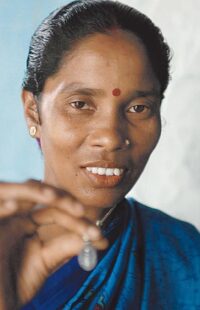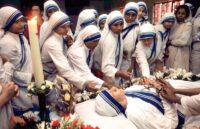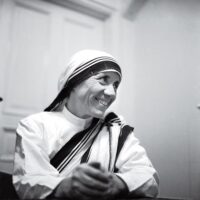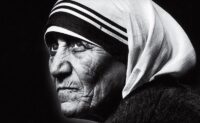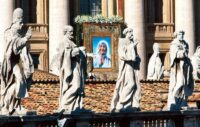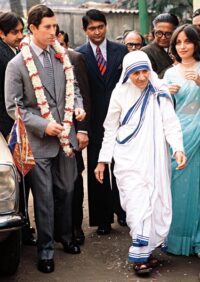As the 100th anniversary of the birth of Mother Teresa of Calcutta on August 26, 2010 approaches, David Van Biema — former chief religion writer at TIME and the author and editor of TIME Mother Teresa: The Life and Works of a Modern Saint — sat down to discuss the life and legacy one of the most iconic human beings of the 20th Century.
Busted Halo: Like John Paul II and the Dalai Lama, Mother Teresa is such a titanic figure in this media age. Can you talk a little bit about her appeal?
David Van Biema: Well, I think it is multifaceted. There are certain people who, when they get into the limelight, if people understand at all what they are doing they love them, and she is one of them. I also think that she specifically has an appeal to my generation; I’m a baby boomer. She began her ministry and order in 1948, which roughly corresponded to the Cold War, and died not that long after the Cold War ended. I remember the drills where you had to get under the desk. We couldn’t afford a bomb shelter so we had a little purple cabinet in the basement filled with dried cereals — in the event of an atomic attack. I had this very strong notion, as I think a lot of people did, that there were people that could do tremendous evil by pushing a button, without actually seeing the effects of their actions.
At that time, the good was also done in a similar way, because it was an era of pretty big government. One got the feeling that there were very good-hearted bureaucrats at the heads of these social programs, and they pushed a button, and something good would happen. But that really seemed no more intimate than the Cold War. I think that Mother Teresa may have given people of my generation this notion of the intimacy of love. A kind of love that is total one-on-one. We have pages in the book that are filled with her holding two sides of peoples heads looking straight into their eyes. Her notion of helping was a very intimate communal notion, of herself or one of her sisters, and one of the poorest of the poor, and Jesus Christ. I think that this was immensely attractive to a generation of people who saw things often being done at a distance.
BH: I was surprised to learn that Mother Teresa came from a reasonably affluent family. Is there anything in your research for this book that surprised you about her?
DVB: Some of what working on a book like this is about, is trying to figure out what a saint is. But in other ways, doing this book sort of disabused me of the notion — if in fact I ever really had it — that God has to come down and just flick a switch in a person. I think, to some extent, maybe more for non-Catholics than for Catholics, there is this notion of sainthood as being like this click-boom kind of thing and a sow’s ear is turned into a silk purse. I think that Mother Teresa encouraged this perception in a way. She never wanted to talk about the fact that her family was reasonably well to do when she was growing up. She talked about how some of her family members were peasants, which was undoubtedly true, but her immediate family was not. And in fact, if you look at her upbringing you can look at her family and you can see sort of the competencies that she showed later on in her life, being able to organize people and some understanding of power, sort of a basic educational level, a tolerance for other faiths — because in the area of Macedonia where she lived it was important and her father especially, had to be involved with that because he was elected city council in a city where Albanian Catholicism was a real minority. Her family was very involved in hands-on charity when they had money. Her mother basically did the rounds; she helped people; she gave away money; people lived with them. So again this was not a totally new concept to her as she got older. I guess what I am trying to say is that instead of flicking a switch, God sort of prepared the circuit ahead of time.
BH: That said, there are also some people who had real problems with her?
DVB:People asked how come she couldn’t build medical clinics, because at a certain point there was enough money to build medical clinics. Why did she just continue to build houses with sisters in them doing the same thing they’d been doing? The argument against that is that medical clinics are cherry-pickers. If they can help you, they will help you. It’s like triage, and she was the opposite of triage. At the same time, there’s another way of turning that criticism: to say that she was more concerned with suffering with the poor, with the notion of a good death and being there for people who might be dying, than she was with actually keeping people from that suffering. Now I think that, that is very debatable if you look at how much food passed through her ministry, if you look at anti-leprosy drugs that she in some ways pioneered the distribution of. But there are also charges that the sisters aren’t necessarily encouraged to use state-of-the-art means to try to help people in the most efficient possible ways, and I think that to some extent those things may be related. She constantly said, “We are not social workers” and I think this is what she meant: if you were looking for doing greatest possible good for the greatest possible number of people, I’m not certain that she was your saint. But what she did was very intense good for people who were in very great need.
BH: Do you think this criticism is simply the byproduct of being so well known?
DVB: At a certain point she ceased to be just of the church and really became of the world, and in a weird way. In an age of celebrity, I think these rather holy people attain a certain public familiarity and they are thrown in the same bag as other famous people, and once you’re famous you are under extraordinary scrutiny. There will always be people who don’t like aspects of what you are doing. With her, it was not really that hard, especially if you had certain opinions. If you are pro-choice, she wasn’t for you. Her spirituality was sort of a pre-Vatican II spirituality, so people who were much more post-Vatican II in the way they saw things might have some difficulties with her. I think had she just continued to do incredible good in Calcutta these questions may not have been raised.
BH: I like the Bob Geldof quote in the book that is along the lines of, “She is deft as any politician or public person I’ve ever seen, but everything she does seems to be for the benefit of others.” Did you get a sense from your research that Mother Teresa was very conscious of her place on the world stage?
DVB: She always claimed to be very uncomfortable with it. But, I think it is a little more complicated than that. I think that at a certain point, one of her biographers said that she had become an expert at the airport homily. She really spent all her time in the air for the last part of — a good deal of — her life. That meant, sort of, public event after public event, and I think that she understood those to be for the benefit the granular stuff and when she came back to Calcutta, she engaged in the granular stuff again — but I don’t think that you can really say she hated it.
BH: Do you have a sense at all of what the letters that revealed her long dark night of a soul did for her image or her reputation?
DVB: Well, within the church, I think they have only burnished her reputation. The idea that somebody could play without the ball as it were for forty-nine years is just an extraordinary thought. Although there are letters that suggest that there were times when she had doubts, those are in the small minority — they are like three or four of them out of more than one hundred. For the most part the letters just talk about how sad she is and so that could be described as heroic.
I think that outside of the church, there may have been at least initially a little bit more confusion, as in, “How can somebody who had doubts of any sort be regarded as a saint?” But for us, she is a different kind of saint, she’s a more complicated person; she’s more three-dimensional. She’s somebody who raises questions that we don’t necessarily know all the answers to. We think of saints very often as people who raise questions that we know the answer to or who they themselves are the answer to the question. She is a saint in many people’s eyes who happens to have done what she did not only during the Cold War but also during the post-Freudian period. Which means that someday somebody is probably going to take those letters and anything else that [postulator to her cause for sainthood] Fr. Brian Kolodiejchuk might write about — because he has access to all this stuff — and really figure out how she fits in as a modern figure. I think that we have taken a step in that direction and the publication of the book of her letters actually raised that possibility, but we are not there yet.
BH: Did you get a sense of Fr. Kolodiejchuk’s feelings about all that we are learning about Mother Teresa now?
DVB: Well, I think a good deal of the dark night was surprising to him. Fr. Brian so far as I know didn’t know about it until he started discovering these letters, after he put out the dragnet while he was working as postulator. I think he was shocked and fascinated and then he said he actually read some of the letters to the sisters and he said their jaws drop. I think he was well aware of the way the letters made her a more interesting, complicated and in some ways tricky figure than she had been before. But I truly think that he welcomes this; he is totally at peace that these only accrue to her heroic virtue.
BH: As a self-described secular Jew, what it’s like covering religious issues so closely?
DVB: This is going to sound like a faint answer, but I have become a slightly more observant Jew. [Laughs.] If you’re asking how a humanist or how a non-spiritual person looks at faith, and why they could be jazzed by it while at the same time not making an obvious trip of faith themselves, and I think I would place myself in that general category. I think that just as faith has ways of explaining humanism, humanism has ways of explaining faith, and I don’t tend to write about it for the most part, but I’m reasonably comfortable in thinking about the tremendous breadth for the human soul and the capacity that we have both for good and for evil, and all the things in between, and I find it extremely nourishing to be able to write about the beauty of the structures of thought that contribute when faithful people act good because of faith. That doesn’t necessarily rule out being able to write about what happens when people of faith don’t necessarily act well.
BH: We started our conversation talking about the image of Mother Teresa being the perfect saint for the boomer generation. Do you have any thoughts about what her life might represent to millennials?
DVB: One of the things I have thought about is how several of the defining aspects of the boomer generation — these great monolithic movements and institutions that existed — seem to have broken down. Now, big defining things like power, influence, etc., are much more fragmented. I think it’s more consistent with what she was doing because I think that for the boomers she was an example of how things weren’t necessarily monolithic and institutional. This sort of granular, one-on-one work that she was doing was more consistent with how we see the world now. Whether the kind of communication that we are engaged in at this point is sort-of intimacy or virtual intimacy, I think to some extent is still an open question. She was engaged in one-to-one intimacy and maybe if I were a millennial, I would ask myself the question: “Am I engaged in virtual intimacy or straight up intimacy?”
